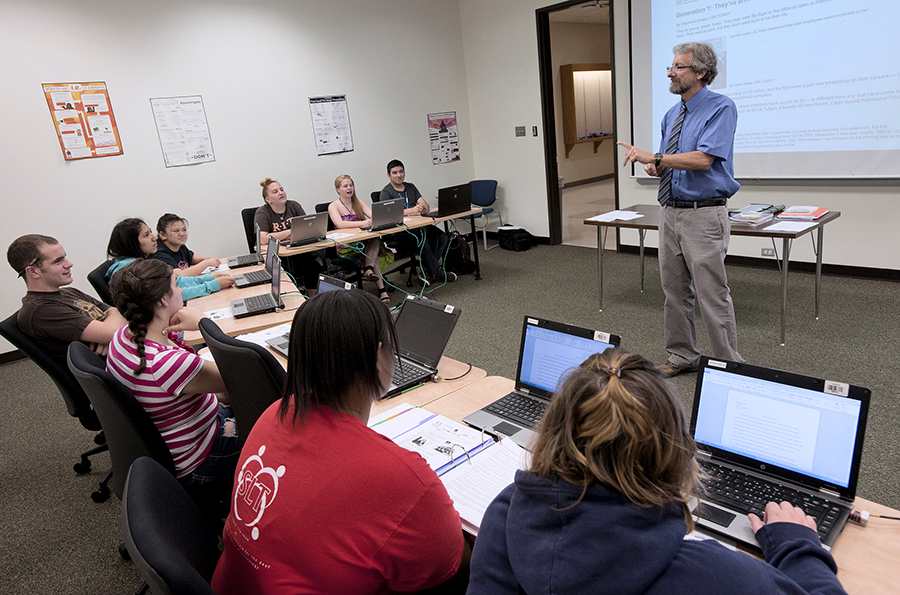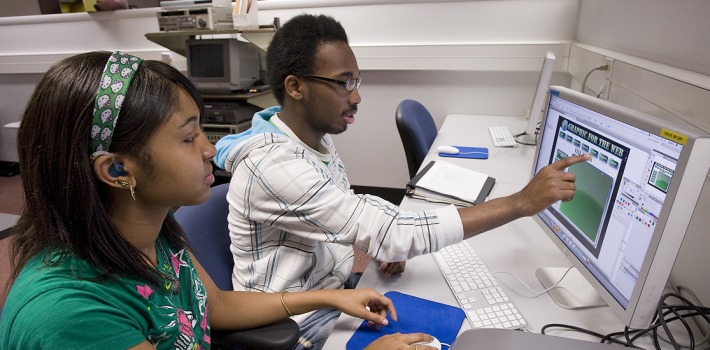
May 15, 2017
RIT Spearheads Program to Attract Deaf Students to Technical Design
We speak to the leaders of a new program at RIT that is focused on educating deaf and hard-of-hearing students in the field of three dimensional graphic design.

The National Technical Institute for the Deaf (NTID) at Rochester Institute of Technology has launched a new, innovative program that will be the first ever of its kind. The associates degree in 3D Graphics Technology is focused on educating deaf and hard-of-hearing students in the field and concepts of three dimensional graphics along with creative and technical design skills. Metropolis got a chance to sit down with Kurt Stoskopf & Heather Smith-Schmitz, veteran NTID faculty members who are also deaf, to talk about their new program and why it’s so important.
Gretchen von Koenig: What was the motivation for starting the program?
Heather Smith-Schmitz: It all started back in one afternoon in 2011 when I was walking with another faculty, Kurt Stoskopf, who shares the same passion for 3D animation. I was coming from my day job as an environmental graphic designer at an architectural firm, where I did a lot of visualization work with 3D renderings. As I was walking with Kurt on the way to my night class, where I taught as an adjunct, I said to him, “Wouldn’t it be cool if I could offer 3D training to our Deaf and Hard-of-Hearing student?” I was explaining to him how the industry has changed, how the workload has changed, and how the expectation from clients has changed as well. They now want 3D renderings as part of the standard services offered. I saw the needs in the different areas of architecture and engineering where they use a lot of rendered works for different purposes. I immediately thought of the opportunity for Deaf and Hard of Hearing students to acquire those kinds of skills. Kurt said, why not?
Five years later, here we are. Kurt and I are here and ready to start our first classes at the National Technical Institute for the Deaf at the Rochester Institute of Technology. No words can describe how we felt when we first learned that this brand-new program had been approved by the New York State Education Department. It’s a little surreal!
During the 5 years of building this new program, we worked very closely with the department of 3D Digital Design in the College of Imaging Arts and Sciences, to build a 2+2 curriculum, where our Deaf and Hard of Hearing Students will continue to earn a BFA degree after completing their AAS degree with us in the 3D Graphics Technology program at NTID.
GK: How do you plan to adapt a traditional design curriculum, typically centered on information relayed aurally, to fit the needs of deaf/hard-of-hearing students?

Kurt Stoskopf: This quote by George Veditz from 1910 pretty much sums up our philosophical approach to teaching:
“Wherever the deaf have received an education the method by which it is imparted is the burning question of the day with them, for the deaf are what their schooling make them more than any other class of humans. They are facing not a theory but a condition, for they are first, last, and all the time the people of the eye.”
When traditional classroom lectures are delivered, many teachers use the spoken word, and then they go on and on. The deaf/hard of hearing students who depend on sign language, and who find themselves in this kind of classroom situation tend to lose focus and stop paying attention in class. To avoid this, and to keep our students interested, we designed the curriculum for the 3DGT program to communicate information using visual means.
Heather and I have designed our lectures to be taught primarily using sign language, while still including the spoken word and using lots of visual examples. Working with deaf/hard- of-hearing students requires advance preparation to ensure that concepts are broken down and explained clearly and sequentially. Based on our previous experience teaching deaf/hard-of-hearing students, our teaching approach revolves around instruction, demonstrations, and hands-on time to apply that knowledge. We plan our courses to allow equal time in our classes to enable students to watch and do.
GV: What kind of tactics do you employ to teach the often complex, esoteric interfaces of 3D modeling programs?
KS: Our classrooms are set up with the desks arranged in a “U” shape. It has a podium and desk where we stand or sit, with a large display monitor to mirror what we are doing on the computer. Having a large display monitor allows us to get up and move around the room and can point at the screen and discuss what they see. The “U” shape arrangement allows students to see everybody else in the classroom. This gives the class an opportunity to follow signed conversations and see who is talking.
Heather and I have worked on a system that we plan to implement throughout all the courses in the 3D Graphics Technology program; we will incorporate QR codes into the course reading materials and project papers. When students scan the QR codes with their mobile devices, they will be able to view short videos that will either define terminology used, offer short explanations of 3D graphics concepts, or short mini-demonstrations on how to accomplish a specific task using the 3D software used in the class.
These QR-linked short videos will use sign language and have subtitles and screen captures to provide information for our students. This ensures students have consistent access to information. Doing this does require more time for course preparation, but it gives our students immediate access to information.
GV: For students entering the program, what are some of the projects they can look forward to and what kind of competencies can they expect to gain?
HS: We want our students to gain experience in articulating their ideas with sketching, visualizations, and focusing on the fundamental skills of 3D modeling and rendering, and cover the history of the 3D graphics industry.
We plan to offer a variety of projects that cover subjects in environmental design, hard surface modeling, 3D object and character modeling, lighting and rendering, and animation. We will give our students a comprehensive knowledge of 3d techniques and digital sculpting along with storyboarding and visualization.
Students who complete the 3DGT program will walk away with a strong demo reel and possess a fundamental understanding of 3D modeling with UV, texturing, lighting, rigging, and rendering. They also will get to work in the different stages in the production pipeline, such as producing 3D graphics, 3D prints, and renderings that range from artistic to photorealistic in quality. Students will also have opportunities to work with external clients to hone their 3D skills. Students will not only acquire the necessary technical skills, they will also gain confidence in themselves and develop professional work ethics.

GV: Going forward, how will the curriculum be changed to respond to the needs of the students and the ever-changing world of design and technology?
KS: Academic curriculum is often slow to change to address rapid changes in the industry. The nice thing about being at RIT and NTID is that they understand this, and are supportive of changes when they need to be made. We monitor changes in the industry from discussions in industry forums, get feedback from our advisory board, and attend SIGGRAPH to get an idea on what emerging technologies and approaches are out there on the horizon. We also have a strong relationship with the College of Imaging Arts and Sciences’ 3D Digital Graphics BFA program and its faculty. They have been important collaborators in developing the 3DGT program. The key is to have an adaptive mindset and be open to new ideas and trying them out.
GV: If graduates of the associates degree wish to continue in the Bachelor’s degree program, what kind of challenges will they face?
KS: The transition is often a challenge with two factors to consider in the transfer process. Students must have a strong portfolio of their work and strong communication skills. To help ease the transfer process for our students, the NTID 3D Graphics Technology AAS degree program has developed a transfer articulation agreement with RIT’s College of Imaging Arts and Sciences 3D Digital Design BFA program that enables students who complete their AAS degree and have a GPA of 3.0 or higher to enter the BFA degree program at the third-year level in the program.
The technical details aside, the additional challenge deaf/hard-of-hearing students also face upon beginning the Bachelors’ degree program, is that they suddenly find that they must work with people who do not know sign language, and may not know how to communicate well with deaf/hard of hearing individuals, or even want to try! Heather and I have designed the courses to include opportunities to work with clients, students from outside the 3DGT program, and have a 10-week co-op experience requirement that will allow students to get industry work experience while they are studying towards their degree. As deaf faculty members, Heather and I will also share our experiences working in the industry, with clients and co-workers, and share tips and techniques to help overcome that brain freeze people often get when meeting a deaf/hard-of-hearing person for the first time!





